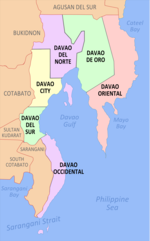Davao Oriental
Davao Oriental
Silangang Dabaw | |
|---|---|
|
| |
 Location in the Philippines | |
| Country | Philippines |
| Region | Davao Region (Region XI) |
| Founded | May 8, 1967 |
| Capital | Mati |
| Government | |
| • Type | Province of the Philippines |
| • Governor | Corazon Nunez-Malanyaon (Nacionalista) |
| • Vice Governor | Jose Mayo Almario (Lakas-CMD) |
| Area | |
| • Total | 5,679.64 km2 (2,192.92 sq mi) |
| • Rank | 15th out of 81 |
| Population (2010)[2] | |
| • Total | 517,618 |
| • Rank | 54th out of 81 |
| • Density | 91/km2 (240/sq mi) |
| • Rank | 70th out of 81 |
| Divisions | |
| • Independent cities | 0 |
| • Component cities | 1 |
| • Municipalities | 10 |
| • Barangays | 183 |
| • Districts | 1st and 2nd districts of Davao Oriental |
| Time zone | UTC+8 (PHT) |
| ZIP code | 8200 to 8210 |
| Dialing code | 87 |
| ISO 3166 code | PH-DAO |
| Spoken languages | Cebuano, Davawenyo, Mandaya, Kamayo, Chavacano de Davao |
Davao Oriental (Cebuano: Sidlakang Dabaw, Filipino: Silangang Dabaw) is a province in the Philippines located in the Davao Region in Mindanao. Its capital is Mati and borders Compostela Valley to the west, and Agusan del Sur and Surigao del Sur to the north.
Davao Oriental is the easternmost province of the country with Pusan Point as the easternmost location. The Philippine Sea, part of the Pacific Ocean, faces Davao Oriental to the east. Part of the province lies on an unnamed peninsula that encloses the Davao Gulf to the west.
History
Prior to its creation as an independent municipality, Davao Oriental was once part of the historical province of Davao.
In 1942, the territory of what is now Davao Oriental was occupied by the Japanese Imperial forces.
In 1945, beginning the Battle of Davao from the combined forces of the British, Australian, Dutch and the Filipino troops of the 6th, 101st, 102nd, 103rd, 104th, 106th, 107th and 110th Infantry Division of the Philippine Commonwealth Army and 10th Infantry Regiment of the Philippine Constabulary was supported by the recognized Davaoeño guerrilla fighter units by the attack to the Japanese Imperial forces during the liberation in Eastern Davao or Eastern Davao Campaign until the end of the Second World War.
On May 8, 1967, by virtue of Republic Act No. 4867, Davao was divided into three provinces, one of which was Davao Oriental.[3]
This section needs expansion. You can help by adding to it. (December 2015) |
Geography
Physical
Davao Oriental is situated on the southeastern tip of Mindanao facing the Pacific Ocean. The Eastern Pacific Cordillera mountain range encompasses the province. To the east of the range lie narrow strips of coastal areas, which feature several inlets and bays.[4][5] The province encloses the Davao Gulf to the southwest.
Administrative divisions
Davao Oriental comprises 10 municipalities and 1 city.
Demographics
| Year | Pop. | ±% p.a. |
|---|---|---|
| 1990 | 394,697 | — |
| 1995 | 413,472 | +0.87% |
| 2000 | 446,191 | +1.65% |
| 2007 | 486,104 | +1.19% |
| 2010 | 517,618 | +2.31% |
| Source: National Statistics Office[2] | ||
The native (and official) language spoken in this province are Kamayo and Mandaya, Cebuano is also spoken here, and Chavacano de Davao being spoken by the people from Compostela Valley and Davao City.
Even some of the natives adhere to Christian faith (mostly Catholics), they are syncretic in some of their beliefs. Folklore beliefs include fairies (diwatas).
Homes are usually made out of wood, with bamboo figuring prominently in many rural abodes.
Economy
Davao Oriental is the copra (dried coconut meat) producer capital of the Philippines.
References
- ^ "List of Provinces". PSGC Interactive. Makati City, Philippines: National Statistical Coordination Board. Retrieved 15 April 2014.
- ^ a b "Population and Annual Growth Rates for The Philippines and Its Regions, Provinces, and Highly Urbanized Cities" (PDF). 2010 Census and Housing Population. National Statistics Office. Retrieved 15 April 2014.
- ^ "Republic Act No. 4867 - An Act Creating the Provinces of Davao del Norte, Davao del Sur and Davao Oriental". Chan Robles Virtual Law Library. 8 May 1967. Retrieved 30 January 2016.
- ^ Wernstedt, Frederick L.; Spencer, Joseph Earl (1978). The Philippine Island World: A Physical, Cultural, and Regional Geography. Berkeley: University of California Press. pp. 32–37. ISBN 9780520035133. Retrieved 27 January 2016.
- ^ Hinz, Erhard (1985). Human Helminthiases in the Philippines the Epidemiological and Geomedical Situation. Berlin, Heidelberg: Springer Berlin Heidelberg. pp. 129–131. ISBN 9783642708411. Retrieved 27 January 2016.
- ^ a b c "Province: Davao Oriental". PSGC Interactive. Makati City, Philippines: National Statistical Coordination Board. Retrieved 16 April 2014.
- ^ "Total Population by Province, City, Municipality and Barangay: as of May 1, 2010 (Davao)" (PDF). 2010 Census of Population and Housing. National Statistics Office. Retrieved 16 April 2014.
External links
 Geographic data related to Davao Oriental at OpenStreetMap
Geographic data related to Davao Oriental at OpenStreetMap- Davao Oriental wants Hamiguitan declared as world heritage site
- Philippine Standard Geographic Code




